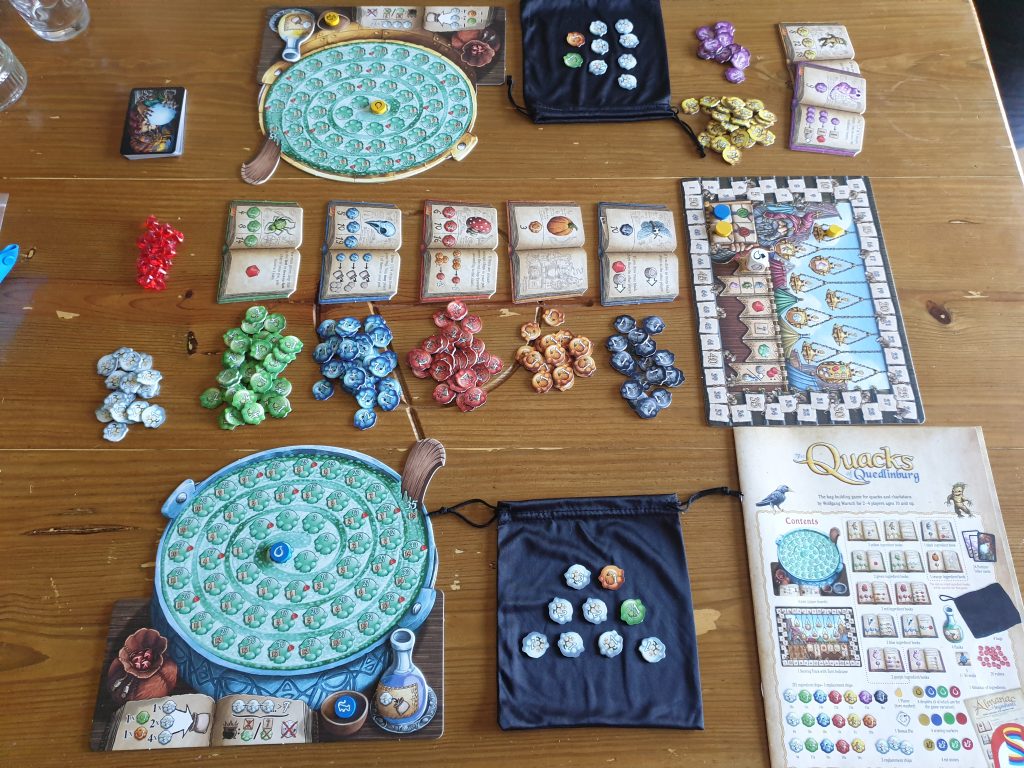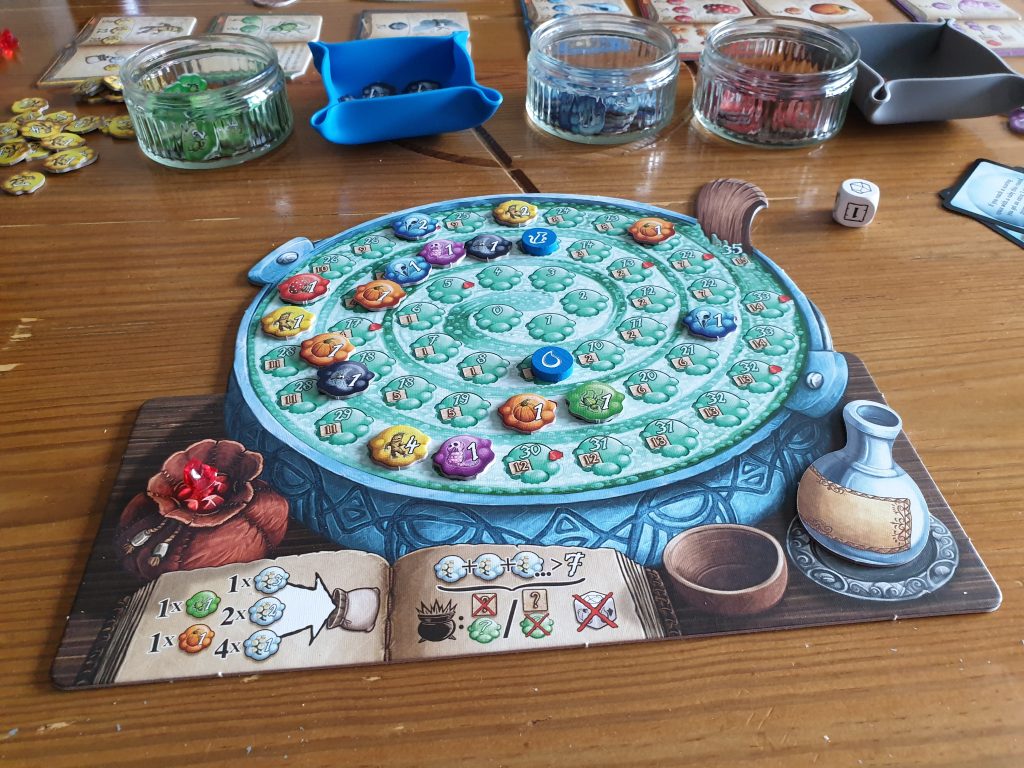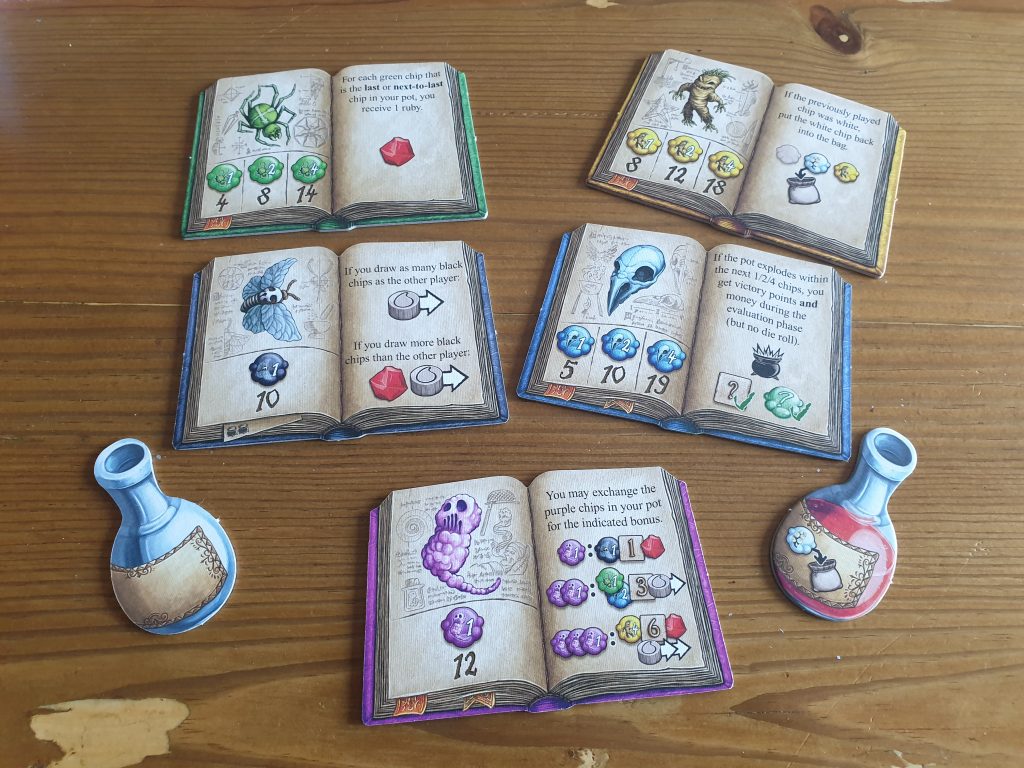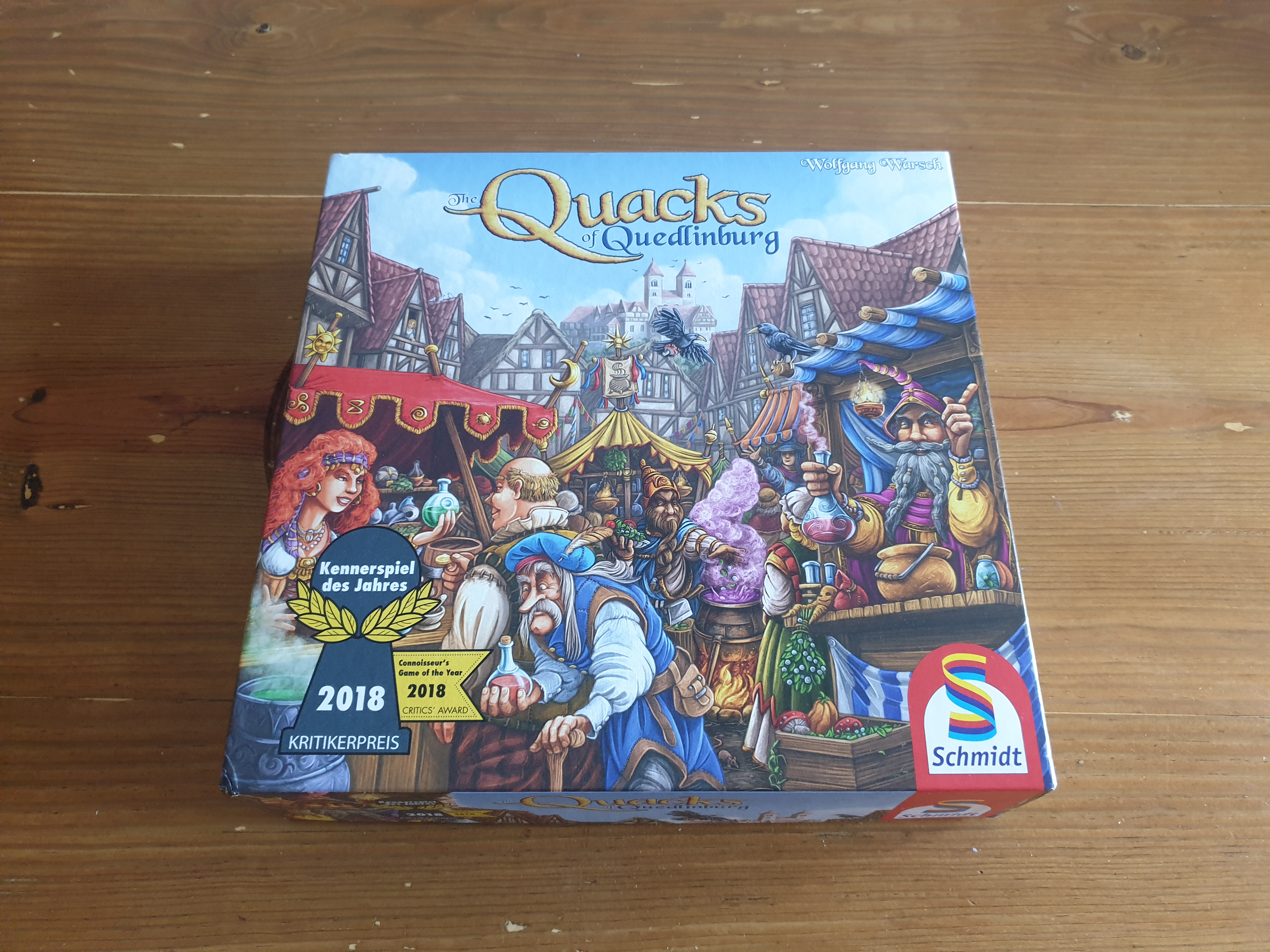The Quacks of Quedlinburg is a 2018 press your luck, bag building, board game from publisher Schmidt Spiele. From one of the hottest designers Wolfgang Warsch, featuring artwork from Dennis Lohausen, the game sees 2 – 4 players brewing potions from peculiar ingredients. Lasting around 30 – 40 minutes these potions are filled with rats tails, toadstools and will occasionally explode! However, should you become a quack doctor? Let’s find out!
The game is played over 9 rounds, these are almost all identical with each having fortune teller, potion making, chip action and evaluation phases. Setting up players need to make individual piles of the colorful ingredient chips. A set of ingredient books is then selected, effectively altering the powers of the different ingredients. These tiles are put next to their respective coloured chips for reference during the game.
Players grab their player boards, bags and tokens. Everyone starts with a full flask, their victory point marker on zero and their droplet token at the centre of their player board on space zero. Each player starts with an identically filled bag. Included are a range of cherry bombs numbered 1 – 3, a single 1 valued pumpkin and a 1 valued garden spider. In the first round these are the only chips you’ll be able to pull out of your bag.

The game hinges on a single rule of if you pull more than 7 cherry bombs in total value then you’re bust and cannot continue. As there is a total value of 11 in everyone’s bag at the start it is therefore risky to keep pulling from the bag. Thus players must push their luck as they blindly draw from their bag. Before each round a fortune teller card is flipped, which will impact that round in a specific way or give everyone an instant bonus. These range from a free ingredient chip to raising the cherry bomb limit from 7 to 9.
Each time a chip is pulled from the bag – whether it would cause the potion to explode or not – it is added to the players personal board. A 1 valued token is placed one step onward from the lowest token or your water droplet. A 2 valued token is placed two steps on and so on. The aim is simple get as far up the tracker as possible without exploding. Players do have one saving grace their small flask. Pouring it into the brewing potion allows a player to remove the last placed cherry bomb chip – unless it caused the potion to explode – putting it back into their bag.
When everyone has decided to stop, or their potion has exploded (effectively going bust), play moves onto the next phase. Firstly, whomever has managed to get the furthest up the tracker gets to roll a bonus die – gifting victory points, a ruby or more. Next, abilities of black, green and purple coloured chips occur. This won’t happen in the first round but can as early as the second. Now, anyone where the next step of their tracker – one up from their highest chip – shows a ruby earns one.
Players whose potion didn’t explode then score the points and have the money to spend indicated on the next step of the tracker. For players with exploded potions they can either score points or have money to spend. Money is not handed out, nor can it be carried over. It can be instantly used to buy up to two different ingredient chips. Players will place newly acquired chips into their bag along with all of their used chips.

Before a new round starts players can trade in two rubies to move their water droplet a step up the tracker – to start from a higher number – or to refill their flask. At the beginning of round 2 yellow mandrakes are added into the pool of available ingredients, followed by ghost’s breath in round 3. To keep the difficulty up whilst players add all the fun new ingredients to their bag in round 6 a new 1 valued cherry bomb is added to everyone’s bags. Finally in the final round, other than everyone pulling chips out at the same time to avoid advantages, rubies and money are instead converted into points. At the end of the 9th round points are totalled with the best brewer the player with the most points.
For those behind in round two and beyond there is a catch up mechanism that can provide a great benefit. The score board tracker has rats across it but between specific values their tails cross the tracker. For each rat tail between a player and the leader a player can add that many rat tails into their pot. This is done by moving the rat token the number of spaces on from the water droplet token in their pot. As being ahead could otherwise see a snowball victory this curbs a potential issue.
It is common for games to have catch up mechanics, so the inclusion of rats isn’t new. It was refreshing to see a leader mechanic as part of this though. The bonus die is a double edged sword that can be beneficial and punishing. Due to being awarded to whomever gets the farthest without exploding there is an extra reason for those who can get far to push their luck a little more to beat a close competitor – increasing the chance of an explosion. At the same time it also makes carrying on a harder decision for someone out in front as they could lose the die bonus too! It encourages and deters at just the right times, meaning everyone has tough decisions to make.
Decisions may be tough but they are never complicated in The Quacks of Quedlinburg. During the drawing phase players merely need to decide whether to pull out another chip from their bag. Go bust and you have another simple decision of victory points or money to spend. Even the purchasing is kept simple by limiting players to only two new ingredients, the choice is often between two lesser costing chips and one that if it comes out the bag would be amazing! This is a feeling the game really drives, the pain of knowing something amazing could be what you pull out next or one of those dastardly cherry bombs.

Component wise there is a lot of cardboard chips but they do a solid job making the game look interesting – mostly due to the vibrancy of the ingredients. They are all exactly the same shape so only eventual wear and tear would give away what chips are what when in the bags. The bags themselves are slightly non-inspiring but stop players seeing inside – some embroidery would have been a nice touch though. The player boards and the tokens all work well to make the game easy to play. I have get muddled a few times by the spiral nature of the potion trackers but this seems to be just me having this issue.
The Quacks of Quedlinburg is one of those games that a lot of positive things have been said about it. On top of this it takes simple easy concepts and actually pulls them off. It isn’t just a standard press your luck game as players build their own odds, by having the chance to pick and choose what goes in their bag. There are plenty of decisions but not enough to daunt even new players. Just as everyone gets their bag full and brimming with great chips there is a final round where players can shoot for the moon before the game ends. It is the perfect time to end leaving you feeling you’ve achieved something and wanting to dive straight back in for more!
[Editor’s note: The Quacks of Quedlinburg was provided to us by Coiledspring Games for the review.]

